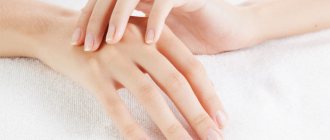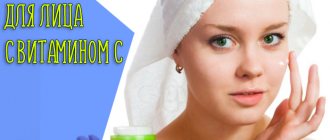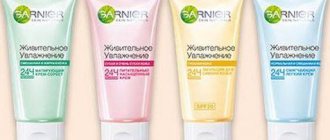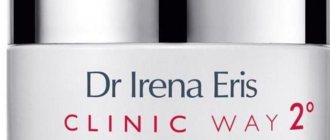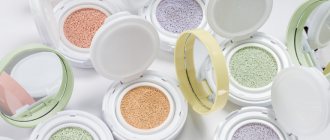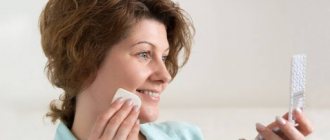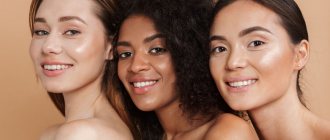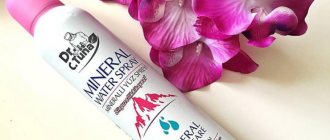When exposed to oxygen, metal rusts and our bodies literally decompose. Reactive oxygen species (oxidants, free radicals) “corrode” us from the inside, destroying us at the cellular level. They steal our health, youth, beauty.
The only weapon against these aggressors is antioxidants. Our body produces them independently. But there are additional sources: food and cosmetics (and this is where modern food and cosmetic manufacturers hit the jackpot).
We understand how antioxidants fight with oxidants inside us, and how we can influence the outcome of the battle.
What are antioxidants for?
We all know about the benefits of vitamins and microelements for the skin. What are antioxidants? Often these are the same vitamins, microelements and some other substances. But they were combined into a group to focus on one very specific ability, on which the youth and beauty of our face depends.
This is the ability to fight dangerous oxidation of the cells of our body, which is carried out by reactive oxygen species (free radicals). After all, what is oxidation? This is, in essence, destruction. Our body is destroyed at the cellular level, which provokes all kinds of diseases and premature aging.
Antioxidants are literally “anti-oxidants.” They neutralize oxidants (oxidizing agents), blocking our internal “rotting”.
Some antioxidants are produced by the body itself, and some come from food and cosmetics. If you are young, healthy, physically active and selective in food, then all this oxidative chaos is not scary for you. But most of us need extra antioxidant support.
Let's first figure out what exactly we need to fight.
Antioxidants: protecting cells from destruction
The human body is equipped with a multi-level system of protection against the destructive effects of harmful radicals. It is called the antioxidant system, or AOS. The components of this body's defense system are called antioxidants.
Antioxidants are natural or synthetic substances that can slow down or stop the oxidation process of organic compounds. At their core, antioxidants are also radicals (particles with a missing or extra electron) that are ready to react with “harmful” radicals in order to break (or slow down) the oxidation chain.
The mechanism of action of the main part of antioxidants is as follows: antioxidant molecules interact with active radicals (which leads to the formation of low-active radicals) or destroy intermediate reaction products (as a result of which oxidation slows down, as the rate of formation of free radicals decreases). So, the main task of antioxidants is to break branched chain oxidation.
This is done in two ways. In the first, an antioxidant molecule containing a mobile hydrogen atom interacts with an active particle - a radical leading the oxidative chain - and oxidizes it, resulting in the formation of a low-active radical. Derivatives of secondary aromatic amines and phenols work according to this principle. In the second method, the antioxidant molecule reacts with the intermediate oxidation product, which leads to its decomposition and chain branching, thereby forming a stable compound. This is how organic derivatives of phosphites and sulfides act.
There are three main levels of antioxidant protection in the body: anti-oxygen (prevents “electron leakage” in mitochondria), anti-radical (prevents the formation of radicals) and anti-peroxide (protects cell membranes and enzyme systems of the cell).
A whole complex of enzymes is involved in the work of AOS, among which superoxide dismutase, catalase, peroxidase, and various reductases (glutathione reductase, methionine sulfoxide reductase, diascorbate reductase, etc.) are especially well known. In addition to enzymes, AOS also includes a number of cell metabolites: lipoic, ascorbic and uric acids, the tocopherol family, about 500 carotenoid compounds, flavonoids, polyphenols (4000–5000 compounds), urates and others. Also directly related to the protective system are: the amino acid taurine, the dipeptide carnosine, the catabolism product of heme-containing proteins - bilirubin, melatonin (a multifunctional antioxidant, one of the pineal gland hormones). Often, individual components of AOS work in synergy, enhancing each other’s actions (the process of studying this kind of interaction continues).
The discovery of antioxidants and their first use were associated with an attempt to preserve food for a longer period of time. After the war, the food problem was acute in the Soviet Union: scientists had to solve the pressing issue of extending the service life of products in order to avoid their spoilage. Research by B.N. Tarusov in the 1950s showed that changes in the surface properties of butter are the result of lipid peroxidation. Then vitamins (including E and C) began to be added to products to protect against oxidation. In 1961, biophysicist A.I. Zhuravlev discovered antioxidant activity in living organisms.
There is no uniform classification of antioxidants. However, they are usually divided:
- by molecular structure: they distinguish enzymes (superoxide dismutase, catalase, peroxidase, phospholipase, etc.) and organic compounds with non-enzymatic activity, which are macromolecular (melatonin, transferrin, cerruloplasmin, ferritin, serum albumin) and low molecular (ascorbic acid, glutathione, urea, bilirubin, sulfur-containing amino acids, adrenaline, steroid hormones, some vitamins, ubiquinone, flavonoids, some types of trace elements);
- according to the ability to act in the aqueous or lipid phase: polar (water-soluble) and non-polar (fat-soluble);
- by localization of action in cellular structures: membrane, intracellular and extracellular.
Antioxidants also differ in their mechanism of action:
- “scavengers” - react with all free radicals and neutralize them, restoring them to stable forms;
- “traps” - have an affinity for certain substances with which they react;
- “antioxidants that break biochemical chains” are substances that are even more active than free radicals: by reacting with the latter, these antioxidants make the radicals weakly active.
According to the classification of antioxidants according to A.V. Kudrin and O.A. Gromova (Russian scientists who have published a number of works on the role of microelements in medicine), they can be endogenous (originally present in the body) and exogenous (coming from the outside).
The first include:
- enzymes: superoxide dismutase (SOD) – zinc-, copper- and manganese-dependent, glutathione peroxidase, glutathione-S-transferase, etc.;
- metabolites: glutathione-GSH (oxidized and reduced), glutathione cell cycle, ubiquinone Q10.
The second ones include:
- vitamins and provitamins: alpha-, beta-, gamma-carotenes, vitamin A, retinoids, alpha-tocopherol (vitamin E), phylloquinone (vitamin K), vitamin C, rutin;
- plant substances: ubiquinone (coenzyme Q10), quercetin, polyphenolic compounds, catechins, chlorophylls, pigment complexes, glycosides, essential oils, bioflavonoids, gallic acids, thiol compounds;
- antioxidant cofactors: riboflavin, vitamin B6, pantothenic acid, omega-3, omega-6;
- trace elements: selenium, zinc, cobalt, manganese;
- medications.
We can conditionally distinguish three levels of antioxidant protection of the skin: surface (membrane or barrier protection), extracellular and intracellular.
Surface protection is located in the upper layers of the skin and is the first stage of protection against harmful factors (mainly acting from the outside). These include large amounts of fat-soluble beta-carotene, alpha-tocopherol and squalene.
Extracellular – implies protection mainly of the intercellular space from damage. It includes: alpha-tocopherol, vitamin C, glutathione, superoxide dismutase, glutathione peroxidase (containing selenium), catalase.
Intracellular protection contains all types of antioxidants. It is carried out due to fat-soluble antioxidants located in the cell membrane (structural component - lipids) and water-soluble antioxidants (located in the cell membrane and membranes of its organelles in those areas where free radicals are formed and where they come into contact with the cell (outer cell membrane). One of the water-soluble antioxidants in this protection is tripeptide glutathione (its concentration here is much higher than other antioxidants).
What are free (secondary) radicals
Free radicals (oxidants, oxidizing agents) are atoms, molecules or ions that carry an unpaired electron in their outer orbit. What does it mean? The fact that they have a vacant place, and they strive to take away the missing electron from other compounds. They oxidize everything they touch.
Oxidation is the loss of electrons by an atom or molecule upon contact with free radicals.
Oxidative reactions are processes that occur continuously in us. And to a certain extent, the activity of oxidants is useful and necessary. Free radicals are involved in many vital processes: energy exchange, fight against microbes, hormone production, protein formation, etc.
But at some point, oxidants become dangerous. In which? When their number begins to exceed the norm. Then they transform into ruthless aggressors, destroying everything in their path. They destroy molecules and cells, including proteins, lipids and other vital compounds. They “tear” DNA and cause cell mutations. In general, they create chaos - so-called oxidative stress.
All this leads to disease, premature aging and affects our appearance. The list of diseases that are associated with harmful oxidative effects includes cancer, diabetes, asthma, multiple sclerosis, diseases of the heart, blood vessels, joints, etc.
And the reason for such destructive overactivity of free radicals is negative external factors: ultraviolet radiation, cigarette smoke, dirty air, poor diet, contact of the skin and respiratory tract with household chemicals. Frequent stress significantly reduces the body's antioxidant resources.
According to scientists, the norm is if about 5% of substances that arise during chemical reactions in the body are oxidants. Such free radicals, which we need to fight pathogens and for other physiological processes, are considered primary.
Alas, an excess of oxidants is inevitable and destructive. Those “extra” free radicals that no longer play a physiologically beneficial role, but only cause harm, are called secondary.
Destructive oxidation in the body grows like a snowball. The secondary free radical, which has taken away someone else’s electron, seems to “calm down” and become inert. But in fact, he passes the baton to the molecule that he just deprived of an electron. She herself has now become a free radical, already a tertiary one. Therefore, she is looking for another victim to take away the electron from her. This is no longer such a fierce “robber”; she may not have enough strength, but even at this level there is a destructive effect.
If you do not fight the raging oxidants, they will take into circulation even those molecules that previously were always “inactive” and did not enter into chemical reactions.
Free radicals are usually called “reactive oxygen species,” but this name does not exhaust all their varieties. In addition to oxygen, derivatives of nitrogen, chlorine, and lipids take active form.
How does oxidative (or oxidative) stress affect the skin?
When, under the influence of negative external and internal factors, the balance of the oxidative and reductive systems is disturbed towards oxidation, a large number of radicals are formed in the skin, participating in lipid peroxidation. This leads to damage to nucleic acids, cellular proteins and lipids. Such processes have an extremely negative effect on the condition of the epidermis and its functions. Ceramides are damaged - lipid molecules, which are the main building component of the outer layers of the skin, forming a lipid barrier (protecting the skin from dehydration, peeling, irritation, penetration of foreign substances, etc.).
By oxidizing lipids, free radicals provoke a lack of moisture, inflammatory reactions, and the risk of developing bacterial infections and pollution. As a result, damage to the cell membranes of the epidermis and dermis may occur, which will weaken the protective function of the skin and may cause the formation of various cosmetic defects. Proteoglycans and hyaluronic acid are destroyed (which accelerates skin aging).
In addition, free radicals destroy the skin framework, damaging collagen and elastin fibers and preventing their synthesis. (Oxidized collagen molecules become free radicals and bind to each other, forming dimers: the so-called “cross-linked” collagen is formed, less elastic and resistant to the action of enzymes.) As a result, the firmness and elasticity of the skin suffers, wrinkles are easily formed, and tissue ptosis appears.
To prevent (or promptly eliminate) such consequences, doctors recommend maintaining a healthy lifestyle: this includes physical exercise, healthy sleep, avoiding stressful situations, limiting alcohol and quitting smoking, protection from excessive ultraviolet radiation (it is recommended to use products with SPF during the active sun season -protection). In addition, it is important to monitor your diet: it must be properly balanced.
Nina Vitalievna Levushkina, brand technologist at PLEYANA:
“A well-balanced diet will contain adequate amounts of vegetables and fruits. It is recommended to include sea fish and cold-pressed vegetable oils. All this is necessary to replenish the supply of vitamins E, C, A, F, bioflavonoids, coenzyme Q10 and other antioxidants important for the body.”
Also, to protect and restore healthy skin functions, today there is a wide range of cosmetics containing various types of antioxidants.
Types and benefits of antioxidants
The power of antioxidants is that they neutralize free radicals and thereby prevent harmful oxidation.
They:
- eliminate the destruction of cell membranes and prevent cell death,
- stimulate the restoration of damaged tissues,
- rejuvenate,
- increase vitality in general.
Depending on the source of entry into the body, three types of antioxidants can be distinguished:
- Antioxidants that our body produces on its own.
Our own antioxidants are biologically active substances in the form of hormones and enzymes, as well as vitamins. We have different ones, each type of dangerous free radicals has its own. Estrogens, catalase, superoxide dismutase, glutathione peroxidase, coenzyme Q, vitamins A, C, E, etc.Our own antioxidants are the basis for preventing free radical oxidation from destroying us from the inside.
They are enough to fully combat oxidants if you lead a healthy and active lifestyle and have minimized the impact of negative factors on the body (sun, smoking, poor environment, stress, sugar and other junk food, etc.).
But still, over time and due to negative external influences, the body develops a deficiency of its own antioxidants. It needs to be replenished.
- Antioxidants in food.
Represented by vitamins, microelements, acids, flavonoids and other compounds. Most of them are found in berries, vegetables, fruits, herbs, nuts, and oils. Antioxidants are included in dietary supplements in concentrated doses. - Antioxidants in cosmetics.
There are:- Natural.
Their sources are mainly the same foods that we eat, especially vegetable oils. - Synthetic.
In the modern cosmetics industry, many analogues of natural antioxidants are synthesized, but they are not comparable in effectiveness to plant ones.
Important!
No cosmetics will help if antioxidants are poorly produced from within. Start your transformation by working through the internal causes of skin aging. MelAnnett's Grow Marathon is for you.
Antioxidants of youth
Antioxidant groups are biologically active substances that neutralize free radicals and prevent them from destroying healthy cells.
Table of antioxidants of various origins.
Natural (natural)
Natural antioxidants are divided into primary and secondary. Primary: enzymes contained in human cells, minerals and hormones. Our body is an intelligent mechanism that, to a greater or lesser extent, develops protection against free radicals. Secondary vitamins include vitamins; they are also present in our body, and their deficiency is replenished from the outside. Such ANTIOXIDANT VITAMINS are found in large quantities in fresh vegetables, fruits and berries.
Synthetic (medicinal)
Contain synthetic substances that also slow down oxidation processes. The most common are vitamin E, dibunol, probucol, ascorbic and lipoic acid. The release form is different - these can be ANTIOXIDANTS IN TABLETS, ANTIOXIDANT CAPSULES, as well as tinctures and balms. In fact, the form does not matter - the composition is the main indicator. Such MEDICINAL ANTIOXIDANTS also contain additives of plant origin, for example, ginseng, milk thistle, rose hips, ginger root.
Synergistic
MODERN ANTIOXIDANTS are distinguished by functional synergism, which allows achieving maximum protective effect with lower concentrations of substances. ANTIOXIDANTS - MICROELEMENTS with a complex mechanism of action. The presence of a large number of microelements is necessary, since their action is synergistic, and each reaction requires its own set of participants. The more effective the drug is, the more ANTIOXIDANTS and VITAMINS we see in its composition. PREPARATIONS with one trace element as an antioxidant are unlikely to truly fight free radicals. In this case, you need a complex of antioxidants.
THE MOST USEFUL ANTIOXIDANTS are 5 substances: vitamins A, C and E, selenium and lycopene. They stop the process of cell oxidation by free radicals.
And the development of inflammatory processes through oxidation by free radicals underlies most diseases. Oxylic is an antioxidant complex of vitamins, convenient because it contains all 5 main antioxidants.
MAIN ANTIOXIDANTS AND ANTIOXIDANT PROPERTIES OF SUBSTANCES
BETA-CAROTENE is an ANTIOXIDANT, the presence of which in vegetables and fruits is easiest to determine. This trace element gives them orange, red and yellow shades. But not everyone knows that this VITAMIN WITH A POWERFUL ANTIOXIDANT can also give a dark green color (sorrel, spinach, bell pepper). Vitamin A IS THE MOST IMPORTANT ANTIOXIDANT VITAMIN. It normalizes the functioning of the sebaceous glands, helps tissues recover, and promotes the rapid formation of new cells. This ACTIVE ANTIOXIDANT is largely responsible for the healthy and beautiful appearance of the skin.
VITAMIN C IS A GOOD ANTIOXIDANT - it normalizes cholesterol, maintains iron levels, and regulates skin pigmentation. This microelement stimulates the production of collagen, which makes the skin elastic, prevents brittle nails, and strengthens hair.
VITAMIN E is an ANTIOXIDANT with functions essential for the body. It protects against ultraviolet rays and promotes skin rejuvenation. It is difficult to choose the BEST ANTIOXIDANT, but many put vitamin E in first place - it is famous for its anti-carcinogenic effect, as well as for the fact that it prevents the formation of blood clots. In addition, vitamin E slows down fat oxidation.
GOOD VITAMINS WITH ANTIOXIDANTS must contain selenium, which is very familiar to teenagers and people with problem skin, because this microelement fights acne. Also, THIS POWERFUL ANTIOXIDANT maintains the thyroid gland in a normal state and fights tumors.
ANTIOXIDANT dietary supplements cannot do without lycopene. This microelement improves intracellular metabolism and helps reduce the risk of burns. It is also a powerful prevention of cardiovascular diseases. Lycopene began to be included in vitamin complexes relatively recently, so you can count on one hand those complexes that contain the most valuable antioxidant.
So, the BEST ANTIOXIDANTS are those that strengthen the immune system, promote skin rejuvenation, and strengthen the walls of blood vessels.
Other Antioxidants Vitamin B12, vitamin A (retinol), folic acid and pycnogenol are also antioxidants with healing properties. Pycnogenol - which is released from a special species of pine - is a powerful antioxidant. It fights excellent against toxins and is 20 times “stronger” than vitamin C. In addition, pycnogenol enhances the effect of vitamin C.
Coenzyme Q10, which strengthens the body's protective functions and slows down aging.
Many manufacturers of skin care products care about beauty and youth, adding vitamin complexes and antioxidants to creams to make the external product more effective. So, we all pay attention to cosmetics with coenzyme Q10, vitamins A, E and C. All products are good in the fight against age.
SOURCES OF ANTIOXIDANTS
Natural:
Provitamin A
– orange and dark green vegetables: spinach, dried apricots, sweet potatoes. But a necessary condition for its absorption is the addition of fat (butter and vegetable oil) to vegetables.
Vitamin C
– citrus fruits, rose hips, currants, strawberries, bell peppers, white cabbage.
Vitamin E
– grains, nuts, sunflower seeds, barley and salmon.
Selenium
– sardines, grains (especially wheat), liver, onions and garlic, Brazil nuts. However: an excess of selenium (more than 700 mg per day) often causes poisoning.
Lycopene
– many vegetables and fruits are red (tomatoes, pink grapefruit, watermelon, melon, persimmon, etc.).
Synthetic:
Specially produced tableted and encapsulated complexes, an antioxidant complex with selenium, that is, multivitamins containing valuable substances and minerals.
DRUGS - ANTIOXIDANTS
ANTIOXIDANTS AND MINERALS, which form the basis of anti-aging pharmacology, have taken it to new frontiers. Ineffective dietary supplements are becoming a thing of the past, only effective ones with a proven mechanism of action remain.
It is not without reason that in recent years we have observed a trend towards an increase in the use of vitamin complexes with antioxidants, against the background of which we and those around us notice changes for the better in both health and appearance, and the recommendations and names of these products are transferred from one consumer to another.
Oxylic is the most effective modern antioxidant complex.
For example, it contains organic selenium along with cysteine and methionine - carriers in the body. Without these amino acids, selenium does not work “as it should,” but this trace element is best known as the “longevity vitamin.”
Especially ANTIOXIDANT VITAMINS FOR WOMEN should contain this element. Also, complexes with antioxidant effects are more valuable if they contain a pair of lycopene and beta-carotene. These microelements mutually enhance each other's antioxidant effect. In short, Oxylic is distinguished by a synergistic combination of antioxidants in doses necessary for the body. Vitamins C and E, beta-carotene, lycopene, selenium, which are part of Oxylic, surround phospholipids.
A similar list of antioxidants makes the Oksilik formula work, and this greatly increases absorption in the gastrointestinal tract and “repeats” the food complex.
1 capsule contains 5 antioxidants Instructions Selenium
50 mcg
Vitamin E
36 mg
Vitamin C
300 mg
Lycopene
2 mg
Beta-carotene
2 mg
How to use:
Adults and children over 14 years old - 1 capsule 1 time per day with food.
Duration of treatment – 3-4 weeks
It is not a drug and is well tolerated. However, before using any drug, it is recommended to consult a doctor.
ANALOGUES OF OXILIC
There are no structural analogues of Oxilic with similar active elements.
What can replace Oxylic? Perhaps complexes containing vitamins C, E, beta-carotene and selenium. Or vitamins and microelements separately.
And if you choose a complex based on selenium content, choose the so-called second generation complexes containing improved selenium compounds (associated with organic substances). The price of Oxilic analogues depends on the elements contained.
List of antioxidant drugs
Glutargin provides protection - antihypoxic, antioxidant, cardio- and hepatoprotective. Indicated for liver diseases (for example, hepatitis). Alcohol poisoning can also be treated with glutargin.
Lipin - Known for immunomodulatory protection with strong antioxidant properties.
Epadol, Tecom, Omacor restore the balance of polyunsaturated fatty acids.
Dibikor and Kratal are amino acids that protect against stress. They are famous for their hypoglycemic and neurotransmitter functions. Dibikor is prescribed for diabetes mellitus and other dysfunctions of the endocrine system. Kratal is prescribed for autonomic neuroses and after exposure to radiation.
To summarize, let's say: the best antioxidant complex is enriching the diet with products with natural antioxidant properties, taking vitamin complexes, and using healthy cosmetics with antioxidant components will help compensate for vitamin deficiency and the lack of these substances and fight for the preservation of youth and health.
How old is your skin?
25+30+35+40+
Take the test
Premature skin aging
What measures should be taken to prevent early skin aging?
More details
Deterioration in appearance
The most important question for a woman is whether it is possible to fight wrinkles, sagging skin, and unhealthy complexion?
More details
Exposure to sunlight
Excessive exposure of the skin to sunlight causes premature aging. How to avoid skin pigmentation?
More details
Adverse environmental influences
Sun, cold, wind, dry indoor air, polluted air - all these phenomena have a negative impact on the condition of our skin. Have you thought about it?
More details
Bad mood
Sometimes the reasons for a bad mood are not caused by events happening in our lives. What causes bad mood and how to deal with it?
More details
Stress
Living in the city is a constant stress for our body. How to take care of skin that is deteriorating as a result of psychological stress?
More details
Antioxidants in food
An increased content of oxidants in the body is a death sentence for most of us. It is difficult for humanity to hide from this.
The modern world is far from environmental standards. We inhale and eat a lot of “harmful things”. Our skin is attacked by dangerous radiation, dirty air, and hard water.
And we ourselves exhaust our own bodies with poor nutrition, bad habits and endless stress.
Therefore, most of us need additional sources of oxidants. And the main channel is nutrition.
If you ask the Internet which antioxidants are best to take with food, the first thing they will offer you is dietary supplements (dietary supplements).
Be careful with them!
If you are healthy, then you do not need dietary supplements and medications containing antioxidants. They contain a very high dosage of active substances. Scientists believe that this causes a withdrawal effect after stopping taking the drugs. Your own natural antioxidant capabilities may drop sharply.
Our body is also a pragmatist. He won’t work if some “pills” do it for him. He will refuse to resist dangerous oxidation on his own, and a kind of addiction will form.
And this was proven in experiments on animals that were fed antioxidants in large quantities. Yes, their fight against free radicals improved, but only during a special “diet”. Then their own antioxidant abilities dropped to below normal levels.
Instead of taking dietary supplements, reconsider your diet. Load up on foods that are rich in antioxidants. They contain such concentrations of active components that are suitable for humans, and not for Argentinosaurus.
Types of antioxidant cosmetics
It is important to use antioxidants not only in the form of cosmetics, but also to include them in the diet. But after forty years, the concentration of active substances entering the body decreases. Therefore, their level should be maintained with cosmetics. Manufacturers produce tonics, masks, lotions. Active substances are added to creams and serums.
It is recommended to use antioxidant cosmetics if the production of melatonin and glutathione is impaired. With glutathione deficiency, a person begins to develop skin pigmentation. In cosmetics, manufacturers use astaxanthin, which is many times more powerful than green tea or coenzyme Q10. You can also often see lipoic acid on product labels, which improves metabolic processes. Antioxidant cosmetics include a liposomal form of vitamin C and coenzyme Q10, which promotes collagen production.
The most powerful antioxidants
What do we eat to increase the level of antioxidants in the body?
Products that contain:
- Ubiquinone (coenzyme Q10).
With the discovery of this enzyme, the triumphant march of antioxidants in biomedicine begins. - Flavonoids.
Many of them are pigments that give color to plants. Once in the human body, they stimulate the functioning of enzymes. Contained in dark grapes (in the form of resveratrol), green tea (tannin), red berries (anthocyanins), red onions (quercetin), peel and white partitions of citrus fruits (rutin), etc. - Vitamins A (retinol), C (ascorbic acid), E (tocopherol), K, N (alpha-lipoic acid).
- Microelements: selenium, magnesium, etc.
- Glutathione
(amino acid derivative), - Lycopene
(a pigment that is responsible for the color of a number of fruits).
What are these products:
- Spices and seasonings: cloves, oregano, rosemary, cinnamon, turmeric.
- Bran.
- Herbs: thyme, mint, basil, cilantro, nettle, parsley.
- Berries: rose hips, cranberries, honeysuckle, blackberries, blueberries, strawberries, blueberries.
- Legumes: beans, lentils, beans, soybeans.
- Nuts: pecans, walnuts, hazelnuts, pistachios, almonds.
- Fruits: prunes, plums, pomegranate, dates, citrus fruits.
- Vegetables: onion, garlic, artichoke, ginger, asparagus, radish, beets, broccoli, eggplant, spinach, Brussels sprouts, bell pepper.
What are antioxidants
Antioxidants are molecules that fight oxidative processes in the body caused by free radicals.
The latter are solid, liquid or gaseous unstable particles. They are formed as a result of metabolic processes or enter the body from the outside, for example, with exhaust gases. Oxidation causes cell damage; some of them can be restored, others are destroyed forever. In this case, free radicals perform important functions [1]. Immune cells use them to fight infections [2]. Factors that increase the production of free radicals:
- internal inflammation;
- contaminated air;
- excessive exposure to ultraviolet radiation;
- cigarette smoke.
Antioxidants in cosmetics
“Antioxidants” is one of the most powerful marker words in the arsenal of cosmetic industry marketers. Add it to the description of a cosmetic product, and consumer interest in the product will immediately jump.
It is believed that our internal antioxidants reach the skin as a residual. First, they rush to improve health, maintain the functioning of internal organs, and then the integument gets what is left.
Therefore, it is recommended to supply the skin with additional portions of antioxidants from the outside. Especially if you have it:
- age,
- problematic, prone to rashes,
- exposed to insolation,
- with discoloration.
That is, cosmetics containing antioxidants are a must-have not only for women 30+. These are products for any age. They are needed by teenagers with their acne, and by young women to prevent aging, by everyone who sunbathes, etc.
Antioxidants in cosmetics protect skin cells from damage and slow down the aging process. Healthy young cells “grow”, collagen production (elasticity) increases, and photoaging is minimized.
The main functions of antioxidants in cosmetics:
- Anti-aging:
stimulates cellular regeneration, increases turgor and elasticity, slows down the formation of wrinkles. - Fighting acne and eliminating traces of it.
- Improved complexion and reduced pigmentation.
- Protection from aggressive external factors:
hyperinsolation, cold, wind, dirty air. - Healing of wounds and abrasions, recovery after burns.
Myths about antioxidants
It is believed that these components are scarce in the diet. This is not entirely true. If a person's diet is poor and he eats mostly fast food, then there may not be enough antioxidants. If the menu contains a lot of vegetables and fruits, and occasionally drinks good wine, then there will be enough antioxidants.
One type of antioxidant is enough to fight the aging process. Best used in pairs or groups. By extinguishing the negative effects of radicals, the antioxidant goes into a non-working state and another group of elements helps it work. Even if a cosmetic contains only one active substance, it usually does not have the desired effect.
If cosmetics contain a lot of antioxidants, then they are very useful. This is wrong. It is better if there are several of these components and they are in low concentration. If the cream is too saturated with beneficial substances, then they can turn into pro-oxidants, and produce a negative effect.
List of the best antioxidants
What to look for on a cosmetic product label:
- vitamin C
(Vitamine C, ascorbic acid, L-ascorbic acid, ascorbyl palmitate/ tetraisopalmitate/ glucosamine, tetrahexyldecyl ascorbate), - vitamin E
(tocopherol, alpha-tocopherol, tocotrienol + the same names in Latin), - vitamin B3
(vitamin PP, nicotinic acid, niacin, niacinamide, nicotinamide + the same names in Latin), - carotenoids
(red and orange plant pigments + their synthesized analogues): vitamin A, beta-carotene, retinol, retinyl palmitate, lycopene + the same names in Latin, - polyphenols
(blue and green plant pigments): resveratrol (red grapes, blueberries, cranberries), tannin (green tea), proanthocyanidin (grapes, blueberries, pine bark), pycnogenol (French pine, witch hazel, grape seed), silymarin (milk thistle) , caffeine (Arabica coffee tree), pomegranate extract (pomegranate), - superoxide dismutase
(enzyme of animal, microbial, plant origin), - microelements:
selenium, magnesium, etc., - ubiquinone
(coenzyme Q10, coenzyme Q10, CoQ10) + its synthetic analogue idebenone, - alpha lipoic acid
(alfa lipoic acid, ALA, thioctic acid, vitamin N, berlition, lipamide)
When to use antioxidant cosmetics
Cosmetics containing active substances are necessary if the skin is often exposed to the negative effects of ultraviolet rays. They are used if aging begins, a person has a lot of stress, or there are inflammatory processes. At the same time, synthesized antioxidants are less useful than natural substances. The most effective ingredients are considered to be pine bark extract, red grapes, ginkgo biloba, horse chestnut, and sea buckthorn. Doctors also recommend products with rosemary, green tea and witch hazel.
How to choose cosmetics with antioxidants
It is better to stick to cosmetics with natural antioxidants. They are more efficient and reliable than their synthesized “clones”.
Therefore, it is optimal to choose natural cosmetics, free from “chemicals”.
Vegetable oils contain a record amount of antioxidants
.
Even elemental sunflower oil
is rich in vitamin E, a strong protector against oxidants.
But for the face it is better to choose something more cosmetic. Not necessarily expensive exotics. There are affordable and effective oil options: coconut, hemp, argan, apricot, peach, jojoba, shea butter, grape seed
.
More rare oils are camellia sasanqua, marulu, karanji, buriti
.
Other types of cosmetics that are made from plant materials also fight oxidants: creams, balms, serums, squalane, hydrolates.
It is believed that the sources of the most powerful antioxidants are plants from regions with harsh climates: Siberian larch, sage, mint, rose hips
.
Antioxidants and women's reproductive health
In some situations and conditions, a woman’s need for antioxidants increases or they are required to support a particular function and preserve women’s health.
Taking oral contraceptives
Oral contraceptives (COCs), or birth control pills as they are called, are hormones that not only prevent pregnancy, but also affect other processes. In particular, they suppress the synthesis of the body’s own antioxidants, change the blood clotting system, increase the load on the liver and damage it. Therefore, oral contraceptives, unfortunately, have side effects: bleeding, increased blood viscosity, deterioration of small vessels, darkening of the skin, chest pain. Taking antioxidants helps eliminate some of the side effects: vitamins A and E, rutin and vitamin C. Vitamin E, together with vitamin C and A, participate in the regulation of ovarian function, protect liver cells from damage when taking COCs, vitamin E normalizes blood viscosity, rutin with vitamin They prevent the appearance of spider veins and dark circles under the eyes. And what is very important, antioxidant support when taking birth control pills will help restore your cycle faster after stopping them.
Preparing for pregnancy and pregnancy after 35 years
After 35 years, the ovaries (and the entire reproductive system) begin to work less actively. The reserves of eggs are gradually depleted, and the hormonal balance also shifts towards “slowing down” the reproductive function. This means that the chances of pregnancy gradually decrease, although the woman can still become a mother. However, it is worth considering that the condition of the reproductive system and the entire body is somewhat worse than at twenty years old - previous diseases, unfavorable life factors, age-related changes, and the use of certain medications and contraceptives have an effect. Therefore, women over 35 years of age have a higher risk of pregnancy complications. In addition, the older the woman, the higher the risk of having a child with genetic abnormalities. This is due to the fact that the amount of damaged DNA in the ovaries increases with age.
But the rate at which women's reproductive systems begin to age can be changed with the help of antioxidants. They will protect the eggs from damage, help the body cope with the negative consequences of chronic diseases and bad habits, and thereby increase the chances of pregnancy, and during pregnancy they will reduce the risk of complications.
Mastopathy
Scientists have found that mastopathy is closely related to an increased amount of free radicals in the body. Therefore, for mastopathy, women are often prescribed antioxidants. The most effective in this case are coenzyme Q10, beta-carotene, lycopene, vitamins A and E. In addition to their direct effect, these substances enhance the therapeutic activity of other drugs, eliminate or weaken their side effects, stabilize the nervous system and strengthen the immune system. Antioxidants are taken both during treatment and for the prevention of mastopathy. So, if a woman is at risk for mastopathy (relatives with mastopathy, age over 35 years, late first birth, prolonged breastfeeding, abortion), then taking antioxidant drugs will reduce the risk of tumors in the breast.
The best products with antioxidants
Beauty365 natural products contain powerful natural antioxidants. It consists of plant materials that have a pronounced antioxidant effect.
What you should pay attention to:
- Beauty365 Coconut Oil.
A hit for the care of mature and dry skin. Smoothes out fine wrinkles and increases skin elasticity. Disinfects, relieves irritation and redness, restores. - Beauty365 camellia sasanqua oil.
Has an anti-aging effect + works with skin coloring (evens out and refreshes color, reduces age spots, prevents the appearance of freckles). - Hydrosols of sage, mint, rose, lavender Beauty365.
All four products provide an antioxidant effect, but the strongest is found in sage and mint. When choosing, focus on your skin type. Rose is suitable for mature, dry and sensitive skin; sage and mint – oily, combination, problematic; lavender - all types. Using hydrolates, we cleanse the skin of makeup and impurities (wipe the face with a cotton pad soaked in the product), and also tone and moisturize the face as necessary. - Beauty365 Verbena Hemp Balm.
It combines the power of six plants at once: hemp, coconut, pistachio, shea butter, carrots, calendula. Powerful anti-aging + enhanced nutrition + good natural SPF factor. - Squalane Beauty365.
This is a lightweight sugar cane oil with a dry application effect. Absorbs instantly and leaves no traces. It is good to apply it to the face in the morning, as a base for makeup, and also before a massage with vacuum cups.
But cosmetics are only external skin care. The main thing is to debug all our internal mechanisms so that the blood delivers to the soft tissues everything they need for beauty and youth, and the lymph takes away everything toxic and unnecessary from them.
Come to the “Flourish” marathon and with your own hands give yourself a young face, a slender body, smooth elastic skin and ideal posture in 4 weeks.
Cosmetic care products
It includes all types of cosmetics for face and body skin care. This includes products for cleansing and toning the skin (thermal water, tonic, foam, makeup remover milk, gommages, peelings and scrubs), skin care products responsible for moisturizing, nourishing and protecting (serums, creams, masks, etc.) , oils for care and massage, care products for the skin of hands and feet (used including for manicure and pedicure procedures).
Care products can be applied manually or using some hardware procedures to more effectively penetrate the components of the products into the deeper layers of the skin.
It should be borne in mind that the use of antioxidants (whether in special foods, pharmaceutical or cosmetic products) requires a responsible approach, and it is recommended to follow the instructions of a cosmetologist in this matter. The fact is that an excess of some antioxidants or their improper use (here we can cite the use of tocopherol as an example) may not only not bring the expected effect, but, on the contrary, cause harm to health.
but on the other hand
Who said that free radicals are necessarily bad? Free radicals are not always a dangerous byproduct of metabolism - many processes in the body cannot do without them: immune cells use free radicals to neutralize bacteria, viruses and cancer cells. Does this mean that excessive consumption of artificial antioxidants will lead to disruption of these functions?
As it turns out, yes: Long-term studies have shown that taking beta-carotene, vitamin A and vitamin E increases the likelihood of lung cancer and mortality in smokers and those who worked with asbestos. Women who took supplements with vitamins C, E, beta-carotene, selenium and zinc were more likely to develop skin cancer, and men taking vitamin E increased their risk of prostate cancer. To date, the danger of biological antioxidant additives remains one of the few fully proven effects.
Antioxidant dietary supplements interact with medications: vitamin E enhances the effect of blood thinners, increasing the likelihood of bleeding, and antioxidants can reduce the effectiveness of anti-cancer therapy - therefore, during drug treatment, consultation with your doctor is required before taking any medications or dietary supplements.
In addition, under certain conditions, antioxidants can also act as oxidizing agents: they take away electrons from other molecules, turning them into free radicals.
***
Physiological processes in the body are interdependent, interfering with this fragile system without indications is dangerous: there is no clear evidence of the benefits of antioxidants, but there is convincing evidence of the dangers of taking dietary supplements containing them. A healthy diet provides the body with all the necessary microelements, vitamins and antioxidants without any health risks.
Photo: unsplash.com/Towfiqu barbhuiya, Magalie De Preux, Vedrana Filipović; pexels.com/Nataliya Vaitkevich, cottonbro
